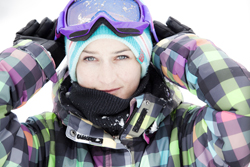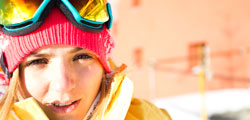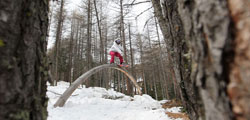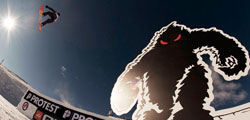
Snowboarding or skiing may be your primary passion, and quite right too. But that’s not to say there isn’t plenty more opportunities for snow-based buzz-chasing
Words by Cherry Martin
Snowkiting
Get ready for a seriously heady adrenaline rush, as air, wind, snow and speed all come together to take you higher and faster than you’ll ever have gone before on a bog-standard snowboarding trip.
If you’ve taken up kitesurfing back home you’ll know what the rush is like – a 10 metre kite can launch you 20 feet into the air at which point you’ll either be holding on for dear life while pretending to enjoy the lovely view, or you’ll be killing it with some bad ass down loops and s-bends to blind. That’s kite speak for laying down some pretty gnarly tricks.
It doesn’t matter how long you’ve been snowboarding, you’ll still need to take some lessons in snowkiting to do it properly. In fact it’s pretty much essential, as British Kitesurfing Association Head Trainer and Easyriders owner Andy Gratwick, says, “Kite control cannot be simply guessed at, and relying on wind and not gravity for a change on the mountain means becoming aware of different weather systems to the ones you’re used to looking out for.”
Wind on the mountain can jump from zero to 50mph within five minutes so to get into this exhilarating sport definitely get yourself some lessons. End of lecture.
Snowkiting takes place wherever there is a large, shallow shelving area in the mountains and has evolved into two main vibes, much like every board sport, you can either spend your time pushing your speed to the max across large open spaces or contorting yourself to nail the next board off or grab above the pow.
Where to do it
Make the journey to the snow kiting mecca of Norway, huge piles of fresh pow land every season on their legendary mountain plateaus leaving you free to explore Northern Norway at 100km an hour. Easyriders Kiteboarding are running a trip there this winter with expert coaching and full kit and board provided for beginners through to experts.
Kit
Your trusty stick, or sticks, of choice when snowboarding or skiing will pair up nicely with a North Kiteboarding Kite. We’d advise buying the kit after your lessons though to know fully what size you need.
Classic rookie error
Falling over the front of the board when riding.
Top tip
Ensure that your board points further downwind which will give you a much smoother ride.
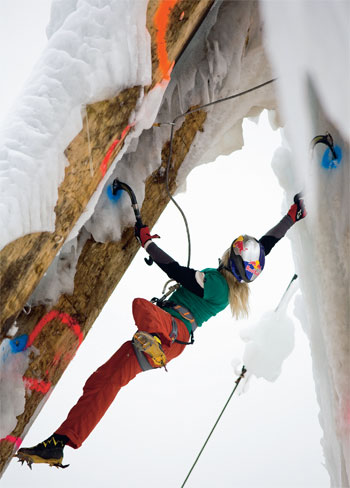
Ice Climbing
Climbing anywhere requires full and total concentration of the mind to deliberate each move. Add solid ice to the equation and you’ve got yourself a totally new challenge. So if you’ve been cooped up with the same 10 people in a chalet driving you crazy for a week and you want forget about it for a few hours, the challenge of scaling the icy mountain is an extreme but totally satisfying form of release. Pro free climber Jenny Leranda first started climbing for this very reason coupled with an obsession for “getting to the top”. She says, “Every move must be planned, as each is critical to your success. You will see the mountain and hidden crevices that normally are avoided by other riders and it’s awe-inspiring.”
Ice climbing requires specific training in the skill of using your equipment to protect yourself from falling and learning how to support your friends in your climbing team. Once learnt you could find yourself scaling anything from frozen waterfalls to sheer icy drops, the kind most sane people steer away from. Conquering an ice face is not something you can do in a rush and you must make sure that you are physically fit enough to support yourself with the challenge.
Where to do it
With more than 35 icefalls, head to the Livigno basin on the northern slopes of the Alps. Geology has lent its hand and created an ideal breeding ground for steep vertical drops, some are even free standing and with the average temperature reaching the lowest in the entire region, the season extends well into April.
Kit
Climbing is hot work in icy conditions so layers of thermals are key. Get yourself kitted out with your own pair of crampons, gloves and a Camelbak to ensure that you stay hydrated and alert for the ascent.
Classic rookie error
Freaking out and getting stuck half way up the climb.
Top tip
It’s all in the mind. Don’t look down, look up and remain focused on your goal. Take a moment to steady yourself and calm your breathing down then carefully plan out your next few moves with your co-climbers supporting you.
Snowskating
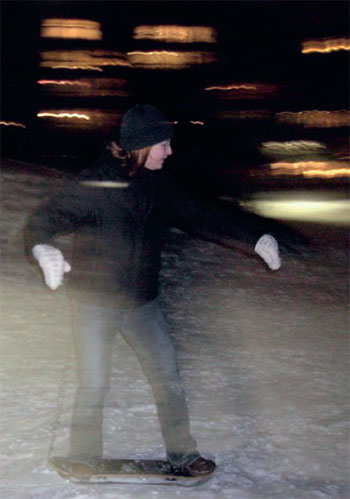
If you prefer wakeskating to wakeboarding you’ll be happy to know there’s a similar snow alternative on offer as well. Riding on or off piste on a snowskate brings a whole new challenge, plus it’s a welcome break for your feet, if you’re like the vast majority of people who strap their bindings on so tight their circulation is in danger. And once you get the hang of it, this quirky little board brings a whole new realm of fun and possibilities to the hill.
When riding you lean in much the same way as regular snowboarding to ensure that you don’t catch your front edge. Keep your feet as far apart as you can to give you more potential balance and bend those knees. If you still prefer your snowboard for cruising, snowskating is a good way to unwind at the end of the day either on piste or flat ground. Ollie and kick-flip your way to unending respect and awe from people watching but try not to stack it too much on the ice. If you haven’t done it before, learn on real snow and not snowflex to avoid the obvious pain.
Where to do it
The joy of this sport is that you can do it absolutely anywhere that there is snow. Chuck it in your board bag and go.
Kit
Good snow skates are hard to find, but Santa Cruz have stayed true to their skate-influenced form of snow riding and produced this little ringer. It’s got a leash attachment, which we’d highly recommend so it doesn’t leave you miles behind when you come off it. Plus it’s just 50 euros and you’re done. Don your snowboard boots and you’re ready to go santacruzsnowboards.com
Classic rookie error
Losing control and ploughing into randoms.
Top tip
Unlike a normal skateboard it’s beneficial to lean back a bit to ensure that the nose of the board remains above the snow line and you don’t catch your front edge.
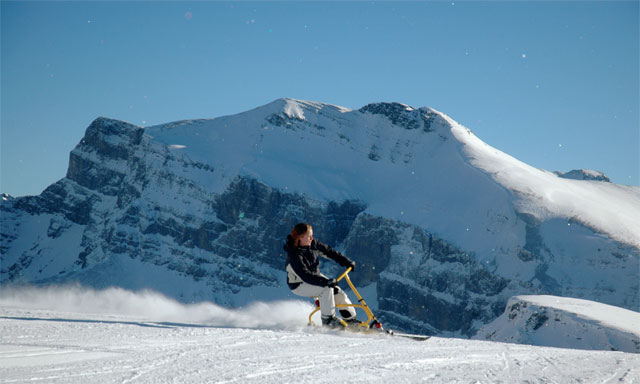
Snowbiking
If standing up all day riding is getting a bit wearing on the old joints and muscles, and sitting back in a seat while winging your way at speed down a slope sounds like a pleasant change then hire yourself a snow bike. A cross between a BMX and a pair of skis leaves much to the imagination and they’re also the kinder option to a snowmobile as they won’t leave a massive carbon footprint or droning sensation in the ears of those passing by.
Over the past 10 years these contraptions have become more and more popular for pegging it down the hill while resting your batty. But don’t be fooled. Anything that slides on snow can, and will inevitably at some point be luzzed over a kicker. Once you get hooked to this challenge you’ll be vying with your mates to see who can be first to nail the backflip and double backflip and so on.
Be sure to invest in a stronger model than is standard for trick nailing purposes. Riding one of these is relatively simple due to the design of the back two blades, which lends you a helping hand on the balance stakes. More hardcore enthusiasts will favour the one blade at the front and one at the back option. You do have a handle to steer the bike on the correct course, as with a BMX you’ll find that once you lean your body weight into the corners it will handle turning in a smoother fashion. Plan out your route back up the mountain before you start whizzing down. These things are hard enough to get on a chairlift let alone trying to tackle a drag lift with one. Though, we’d probably pay good money to watch someone attempt it.
Where to do it
Manufacturing Lord of snowbikes, Brenter, lists everywhere in the world that you can hire them so you can organise it before your trip. They generally cost from 9 euros for a day’s use.
Kit
Grab your ski boots and mini skis and you’re good to go. Buying a snowbike can set you back up to 880 euros for the top range ones, which is only worth it if you’re planning to spend a lot of time in the park on one. They only weigh 8kg and fold down quite well so it’s not inconceivable to squeeze one into your trusty split-roller.
Classic rookie error
Flying over the handlebars and landing spread-eagled in the snow in front of your mates.
Top tip
Keep your arms straight and your elbows locked in. Lean back ever so slightly to keep the front blade angled upwards a touch.

